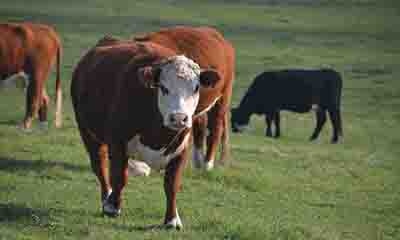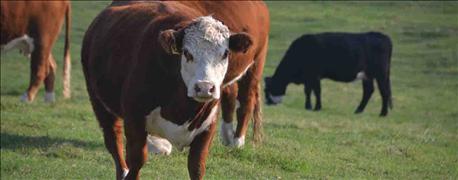May 23, 2016

Ask 10 people to define “sustainable agriculture”, and you’re likely to get 10 different responses. One gray-haired farmer (not me) thought a moment, then said: “I suppose it’s when you have enough money in the bank to farm for another year!”
It’s hard to argue with that definition. Trouble is, many folks want an answer taking into account long-term environmental effects. That’s the tack used by “anti” groups, such as People for Ethical Treatment of Animals, as justification for eliminating animal agriculture.

ON SOLID GROUND: While arable land, worldwide, is slowly shrinking, beef production efficiency is rapidly rising.
But do beef production systems really cause too much environmental damage to be sustainable in the future? Before you get your “ruff” up, a leading expert says “No.”
Jude Capper, a sustainability consultant and former animal science professor at Washington State University, spends much time debunking common myths about livestock’s environmental impact. She recently presented a American Meat Science Association webinar on “Grass or grain: Is there a definitively sustainable beef production system?”
Challenge: Feeding the world
Competing land uses is perhaps the biggest challenge raised by the antis. No one argues that we’ll need to feed 9 billion people by year 2050. By then, world consumption of beef, pork and poultry is predicted to be about 350 million metric tons – about 55% above present consumption.
The United Nation’s Food and Agriculture Organization calculates that arable land per person was about 1.1 acres in 1960. It’s now about 0.60 acres. By 2050, it’ll be less than one-half acre. Considering that available land will shrink, improving production efficiency and sustainability will become increasingly important.
5 points of debunking
When confronted by anti-beef people, consider using these points to counter their arguments that beef – grass-fed or grain-feed – isn’t a sustainable practice:
1. Water use: One of PETA’s web posts, for instance, contends 2,463 gallons of water are used to produce one pound of beef. Another spot shows two models posed in a tub full of bubble bath with a sign saying “One steak equals 50 baths; clean your conscience; go vegan!”
Capper’s calculations are quite different. Most water used in beef production is in the production of crops and forages. Whether conventional (feedlot) or grass-fed systems are evaluated, water used directly by livestock is 5% or less of total use.
Actual gallons of water used per pound of beef are: Conventional system, 258 gallons; grass-fed on improved pastures with 50 % irrigated land, 677 gallons; grass-fed intensive systems with less than 1% irrigated land, 526 gallons.
2. Feed efficiency: Beef production may seem inefficient in terms of total pounds of feed required per pound of animal gain. The conversion rate for feedlot cattle on high grain diets average 5 to 7:1; pasture cattle average 15 to1. That compares to 2.5 to 1 for poultry and around 3.5 to 1 for pork.
That’s not the whole story, though. Much of what ruminants eat are forages and/or concentrates humans won’t or can’t eat.
Looking at “human-edible” efficiency – the feed cattle eat that could be directly consumed by man – beef efficiency is quite competitive. For all-grass systems, no feed directly competes with human diets.
Even for high grain feedlot systems, the conversion ratio of human-edible protein to beef edible protein is about 2.5 to 1. One reason is that much of the calf’s early life is spent on pasture. This compares quite favorably to feed efficiency of pork, broilers and eggs.
Then there’s this claim: “If every American would stop eating beef, we’d have enough grain available to feed 1.4 billion people.” The uninformed don’t realize that much of our grazing lands can’t be used for food crop production. Cattle and other ruminants can make use of feed resources we can’t directly consume.
3. All grass the answer? What if we converted all beef production to a grass-only system? Low forage energy values compared to concentrates requires more feed intake to produce a pound of gain. Simply put, to produce the same amount of beef as we do now, an all-grass would require about 65 million more animals, 435 million more acres of land, and 468 billion more gallons of water.
4. Health issues: Some consumers regard grass-fed beef as ‘healthier” than grain-fed, and are willing to pay $0.60 to $1.00 more per pound for it – even though it scores lower in palatability. In one study, grass-fed steaks averaged 2.8% fat; grain-fed was 4.4% fat. Grass-feed beef also was lower in saturated fatty acids. On the other hand, grain-fed beef was higher in mono-unsaturated fatty acids thought to promote beef palatability and raise blood levels of “good cholesterol”.
Grass-fed beef has elevated conjugated linoleic acid content compared to grain-fed. Increased CLA intake is thought to be ant-inflammatory, improves heart function and helps prevent cancer and obesity. But could we eat enough of it to make a clinical difference?
In a British study, young women received a diet of grass-fed beef and dairy products that resulted in three times the CLA intake of the control group. There were no effects on body composition, insulin sensitivity, blood lipid profiles or blood cholesterol.
5. Real progress: Skeptics often use outdated information to criticize resource use by the livestock industry. What often gets lost in the discussion is the remarkable progress made by the beef industry.
In 2007, four animals could produce the same amount of beef as five animals in 1997 – in 124 fewer days to slaughter. In just 30 years, for each pound of beef, we use 81% as much feed, 88% as much water, require only 67% as much land, and have an 84% smaller carbon footprint.
Capper’s final answer to whether one beef system is most sustainable is “No.” All current production methods being used can be sustainable and profitable. The key is matching the system to the available environment, land resources and marketing to consumer preferences.
Harpster is a beef producer and retired Penn State University animal scientist.
You May Also Like




